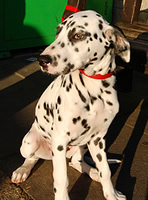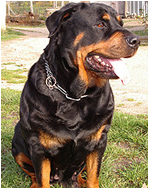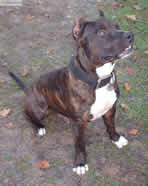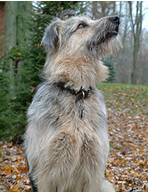
The Newfoundland is an elegant looking dog, with a burly, robust build and
a massive head. This breed is agile, healthy and friendly. It has a short,
broad muzzle, dark nose that varies in color only in dogs that are bronze coated,
dark little eyes, small hanging ears that are angular. It usually has dewclaws
on the rear legs that must be removed. It has swimming legs and feet that are
webbed, and a low hanging tail.
Life Expectancy:
8-10 years
Energy Level:
Mild and laid back.
Living Conditions:
Sensitive to heat. Fine for apartments.
Barking:
Average
Exercise Needs:
Daily walk and occasional swim.
Breed Group:
Working
Size:
Large
Height:
25 to 29 inches
Weight:
100 to 150 pounds
Standard Hair Colors:
Black, black with bluish streaks, gray, bronze, brown, and white with darks spots.
National breed club:
Newfoundland Club
of America
The breed was once used to aid fishermen near the shores of Newfoundland in Canada. It was tasked to pull in nets, recover items that fell into the water, take boat harnesses to the shore, and save drowning or stranded victims. It continues to be a naturally skilled rescuer over water. Other tasks it once did include pulling timber and mail sleds, carrying goods in packages, and milk delivery. These days, it shows talent in water trials, weight pulling, competitive obedience, guarding and carting, and remains an adorable companion.
The Newfoundland is generally endearing with its pleasant temperament. This breed is composed, tolerant, mild mannered, laidback and extremely friendly, yet it is perfectly capable of protecting its master when the situation calls for it. A downside, however, is that it can be a little hard to train. With its huge build, its movement can be quite slow. The trainer must be able to maintain a stable method of instruction when dealing with this dog, as it can be quite receptive to nuances in its trainer’s voice.
Though the Newfoundland tends to be inactive in the home, though it will gain from habitual exercise in reasonable amounts. It loves to swim though, and it is bound to jump into bodies of water to play.
This breed is amenable to apartment living, especially if it still is able to acquire adequate exercise. It tends to be sedentary when at home, though access to a small yard can keep it motivated. The Newfoundland prefers a cool environment. It must not be taken to warm areas without shade, and must be given cool water to drink in warm conditions.
Brushing should be done a few times a week to maintain the Newfoundland’s coat. Even more attention should be given when it sheds in autumn and spring. To maintain shine in the coat, do not bathe the dog unless it’s necessary, and use dry shampoo on its hair instead.
The owner must not let a Newfoundland dog to gain weight, as it is susceptible to the inherited heart ailment known as sub-aortic stenosis. Hip dysplasia is another possible problem.
...you may also like the Alaskan malamute which is also a large breed with a pleasant disposition.

 Siberian Huskys: A guide to dogs and puppies of the Siberian Husky breed
Siberian Huskys: A guide to dogs and puppies of the Siberian Husky breed
 Dalmatians: A guide to dogs and puppies of the Dalmatian breed
Dalmatians: A guide to dogs and puppies of the Dalmatian breed
 Rottweilers: A guide to dogs and puppies of the Rottweiler breed
Rottweilers: A guide to dogs and puppies of the Rottweiler breed
 American Staffordshire Terriers: A guide to dogs and puppies of the American Staffordshire Terrier breed
American Staffordshire Terriers: A guide to dogs and puppies of the American Staffordshire Terrier breed
 Choosing a Cirneco dell Etna – Cirneco dell Etna Breed Profile
Choosing a Cirneco dell Etna – Cirneco dell Etna Breed Profile
 Scottish Deerhounds: A guide to dogs and puppies of the Scottish Deerhound breed
Scottish Deerhounds: A guide to dogs and puppies of the Scottish Deerhound breed
Copyright © 2005-2016 Pet Information All Rights Reserved
Contact us: www162date@outlook.com